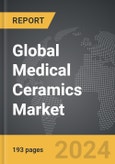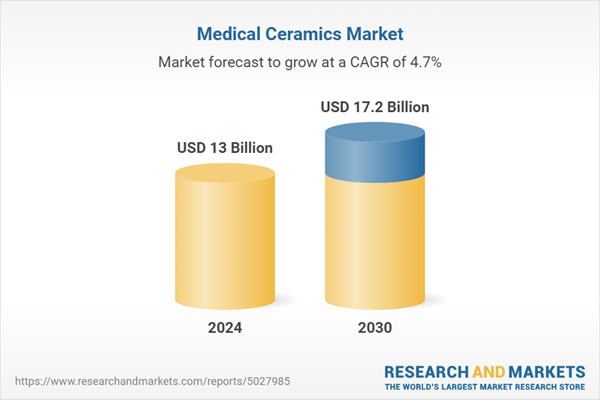The global market for Medical Ceramics was valued at US$13.0 Billion in 2024 and is projected to reach US$17.2 Billion by 2030, growing at a CAGR of 4.7% from 2024 to 2030. This comprehensive report provides an in-depth analysis of market trends, drivers, and forecasts, helping you make informed business decisions. The report includes the most recent global tariff developments and how they impact the Medical Ceramics market.
Segments: Material (Bioinert, Bioactive, Bioresorbable, Piezoceramics); Application (Dental, Orthopedic, Cardiovascular, Diagnostic Instruments, Surgical Instruments, Plastic Surgery, Other Applications).
Geographic Regions/Countries: World; United States; Canada; Japan; China; Europe (France; Germany; Italy; United Kingdom; Spain; Russia; and Rest of Europe); Asia-Pacific (Australia; India; South Korea; and Rest of Asia-Pacific); Latin America (Argentina; Brazil; Mexico; and Rest of Latin America); Middle East (Iran; Israel; Saudi Arabia; United Arab Emirates; and Rest of Middle East); and Africa.
The analysts continuously track trade developments worldwide, drawing insights from leading global economists and over 200 industry and policy institutions, including think tanks, trade organizations, and national economic advisory bodies. This intelligence is integrated into forecasting models to provide timely, data-driven analysis of emerging risks and opportunities.
Global Medical Ceramics Market - Key Trends & Drivers Summarized
What Are Medical Ceramics and Why Are They Integral to Modern Medicine?
Medical ceramics are bioinert materials that are extensively used in various medical applications, including implants and prosthetics, dental devices, and surgical instruments. These ceramics, such as alumina, zirconia, and bioactive glass ceramics, are favored in the medical field due to their compatibility with human tissue, high wear resistance, and ability to withstand high temperatures and pressures. Their use is particularly prominent in orthopedic and dental implants where their hardness and durability mimic natural bone, promoting bone growth without the risk of inflammation or rejection. The aging global population and the increasing incidence of orthopedic ailments such as osteoporosis and dental disorders drive the demand for medical ceramics. As technology advances, these materials are also being engineered to be porous to aid in the integration with bone and enhanced drug delivery, thus broadening their application in more complex medical scenarios.How Is Technological Innovation Influencing Medical Ceramic Applications?
Technological innovation in the field of medical ceramics has led to significant developments that enhance their applicability and performance in medical treatments. Advanced manufacturing processes like 3D printing have revolutionized the production of ceramic implants, allowing for highly customized solutions tailored to individual patient anatomy. This technology facilitates the creation of complex geometries that are not only structurally robust but also optimize integration with the body's tissues. Innovations in ceramic materials have also improved their mechanical properties and biocompatibility, making them suitable for a wider range of applications, including load-bearing orthopedic implants and highly aesthetic dental prosthetics. Moreover, research into nano-ceramics is pushing the boundaries further, enhancing their interaction with biological systems, which could lead to breakthroughs in regenerative medicine.What Role Does the Increasing Global Healthcare Demand Play in the Medical Ceramics Market?
The increasing global healthcare demand, particularly in developing countries, is significantly impacting the medical ceramics market. As healthcare infrastructure improves and access to medical care increases, there is a growing demand for advanced medical treatments and devices, many of which involve medical ceramics. This is particularly evident in the expanding orthopedics and dental care sectors, where medical ceramics are critical for a variety of implants and prosthetic devices. The push for better healthcare facilities and services worldwide is not only increasing the volume of medical procedures performed but also raising the standards of care, thereby driving the demand for high-quality, durable medical ceramics that can enhance the quality of life for patients around the globe.What Are the Primary Drivers Behind the Expanding Market for Medical Ceramics?
The growth in the medical ceramics market is driven by several factors, including the increasing incidence of dental and orthopedic disorders among the aging population. As life expectancy rises globally, there is a greater need for durable and biocompatible solutions that medical ceramics can provide. Advances in medical technologies and the growing acceptance of implantable devices also fuel the demand for ceramics in medical applications. Additionally, regulatory pressures and healthcare policies advocating for more effective and safer medical devices encourage the adoption of advanced ceramic materials. The ongoing innovations in ceramic technology that improve the performance and safety of implants further stimulate market growth. With continued research and development, medical ceramics are becoming an indispensable part of the medical device industry, driving their expansion across diverse healthcare applications.Report Scope
The report analyzes the Medical Ceramics market, presented in terms of units. The analysis covers the key segments and geographic regions outlined below.Segments: Material (Bioinert, Bioactive, Bioresorbable, Piezoceramics); Application (Dental, Orthopedic, Cardiovascular, Diagnostic Instruments, Surgical Instruments, Plastic Surgery, Other Applications).
Geographic Regions/Countries: World; United States; Canada; Japan; China; Europe (France; Germany; Italy; United Kingdom; Spain; Russia; and Rest of Europe); Asia-Pacific (Australia; India; South Korea; and Rest of Asia-Pacific); Latin America (Argentina; Brazil; Mexico; and Rest of Latin America); Middle East (Iran; Israel; Saudi Arabia; United Arab Emirates; and Rest of Middle East); and Africa.
Key Insights:
- Market Growth: Understand the significant growth trajectory of the Bioinert segment, which is expected to reach US$6.3 Billion by 2030 with a CAGR of a 5.7%. The Bioactive segment is also set to grow at 4.2% CAGR over the analysis period.
- Regional Analysis: Gain insights into the U.S. market, valued at $3.4 Billion in 2024, and China, forecasted to grow at an impressive 7.3% CAGR to reach $3.8 Billion by 2030. Discover growth trends in other key regions, including Japan, Canada, Germany, and the Asia-Pacific.
Why You Should Buy This Report:
- Detailed Market Analysis: Access a thorough analysis of the Global Medical Ceramics Market, covering all major geographic regions and market segments.
- Competitive Insights: Get an overview of the competitive landscape, including the market presence of major players across different geographies.
- Future Trends and Drivers: Understand the key trends and drivers shaping the future of the Global Medical Ceramics Market.
- Actionable Insights: Benefit from actionable insights that can help you identify new revenue opportunities and make strategic business decisions.
Key Questions Answered:
- How is the Global Medical Ceramics Market expected to evolve by 2030?
- What are the main drivers and restraints affecting the market?
- Which market segments will grow the most over the forecast period?
- How will market shares for different regions and segments change by 2030?
- Who are the leading players in the market, and what are their prospects?
Report Features:
- Comprehensive Market Data: Independent analysis of annual sales and market forecasts in US$ Million from 2024 to 2030.
- In-Depth Regional Analysis: Detailed insights into key markets, including the U.S., China, Japan, Canada, Europe, Asia-Pacific, Latin America, Middle East, and Africa.
- Company Profiles: Coverage of players such as 3M Company, CeramTec GmbH, CoorsTek, Inc., DePuy Synthes, H.C. Starck GmbH and more.
- Complimentary Updates: Receive free report updates for one year to keep you informed of the latest market developments.
Some of the 43 companies featured in this Medical Ceramics market report include:
- 3M Company
- CeramTec GmbH
- CoorsTek, Inc.
- DePuy Synthes
- H.C. Starck GmbH
- Koninklijke DSM NV
- Kyocera Corporation
- Morgan Advanced Materials PLC
- NGK Spark Plug Co., Ltd.
- Rauschert GmbH & Co., KG
- Straumann
- Zimmer Biomet Holdings, Inc.
Tariff Impact Analysis: Key Insights for 2025
Global tariff negotiations across 180+ countries are reshaping supply chains, costs, and competitiveness. This report reflects the latest developments as of April 2025 and incorporates forward-looking insights into the market outlook.The analysts continuously track trade developments worldwide, drawing insights from leading global economists and over 200 industry and policy institutions, including think tanks, trade organizations, and national economic advisory bodies. This intelligence is integrated into forecasting models to provide timely, data-driven analysis of emerging risks and opportunities.
What’s Included in This Edition:
- Tariff-adjusted market forecasts by region and segment
- Analysis of cost and supply chain implications by sourcing and trade exposure
- Strategic insights into geographic shifts
Buyers receive a free July 2025 update with:
- Finalized tariff impacts and new trade agreement effects
- Updated projections reflecting global sourcing and cost shifts
- Expanded country-specific coverage across the industry
Table of Contents
I. METHODOLOGYII. EXECUTIVE SUMMARY2. FOCUS ON SELECT PLAYERSIII. MARKET ANALYSISCANADAITALYSPAINRUSSIAREST OF EUROPESOUTH KOREAREST OF ASIA-PACIFICARGENTINABRAZILMEXICOREST OF LATIN AMERICAIRANISRAELSAUDI ARABIAUNITED ARAB EMIRATESREST OF MIDDLE EASTIV. COMPETITION
1. MARKET OVERVIEW
3. MARKET TRENDS & DRIVERS
4. GLOBAL MARKET PERSPECTIVE
UNITED STATES
JAPAN
CHINA
EUROPE
FRANCE
GERMANY
UNITED KINGDOM
ASIA-PACIFIC
AUSTRALIA
INDIA
LATIN AMERICA
MIDDLE EAST
AFRICA
Companies Mentioned (Partial List)
A selection of companies mentioned in this report includes, but is not limited to:
- 3M Company
- CeramTec GmbH
- CoorsTek, Inc.
- DePuy Synthes
- H.C. Starck GmbH
- Koninklijke DSM NV
- Kyocera Corporation
- Morgan Advanced Materials PLC
- NGK Spark Plug Co., Ltd.
- Rauschert GmbH & Co., KG
- Straumann
- Zimmer Biomet Holdings, Inc.
Table Information
| Report Attribute | Details |
|---|---|
| No. of Pages | 193 |
| Published | April 2025 |
| Forecast Period | 2024 - 2030 |
| Estimated Market Value ( USD | $ 13 Billion |
| Forecasted Market Value ( USD | $ 17.2 Billion |
| Compound Annual Growth Rate | 4.7% |
| Regions Covered | Global |









